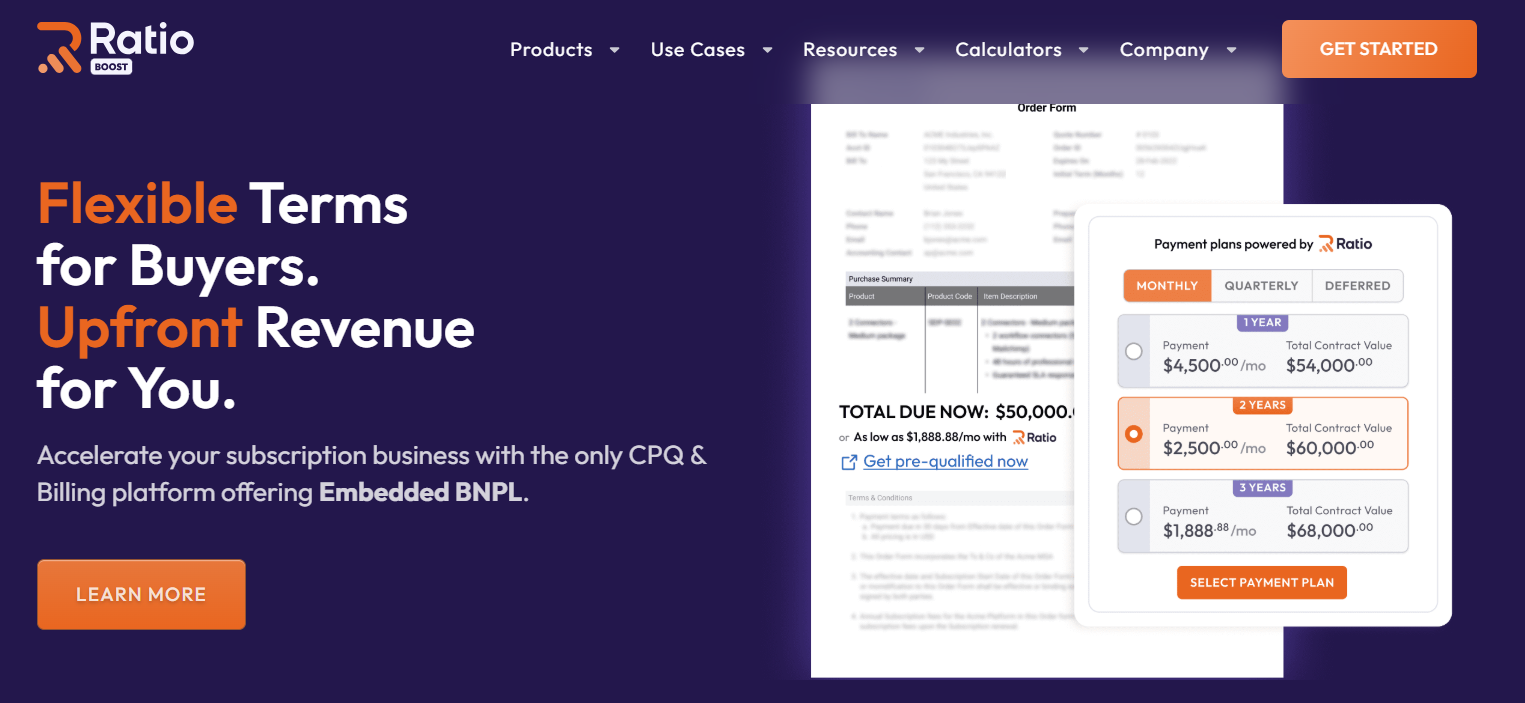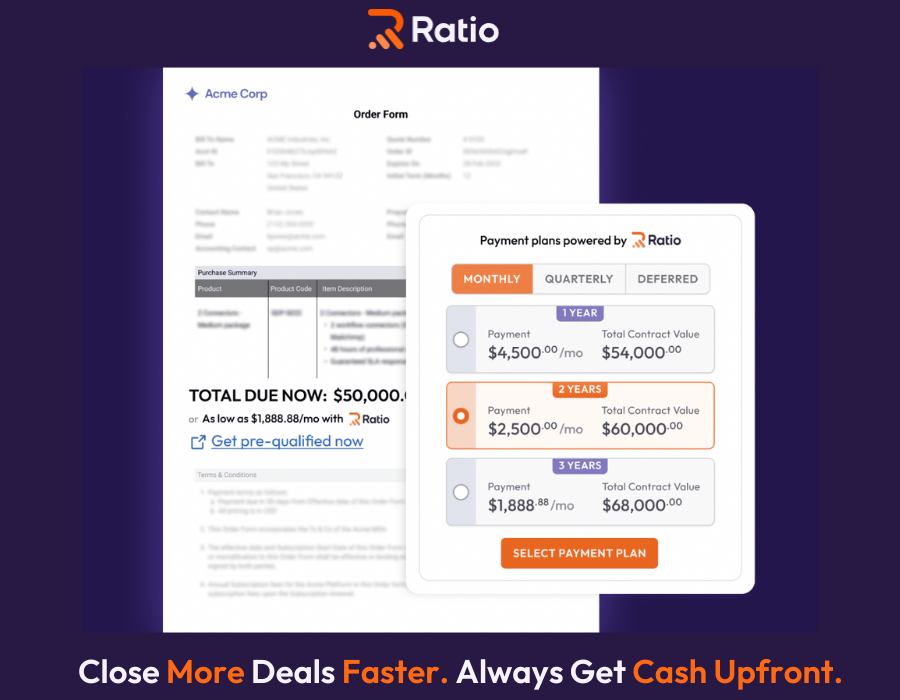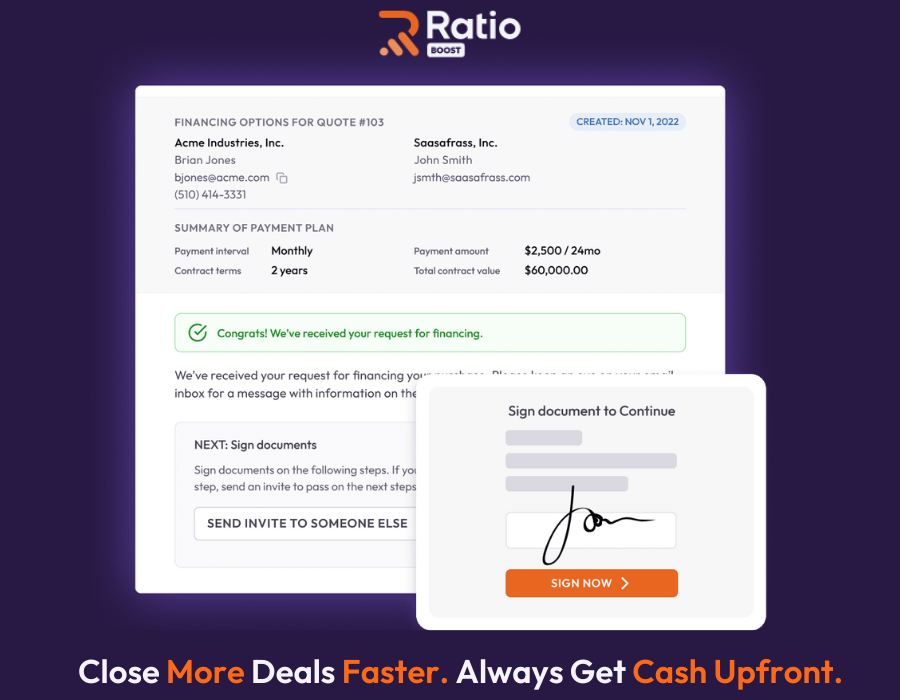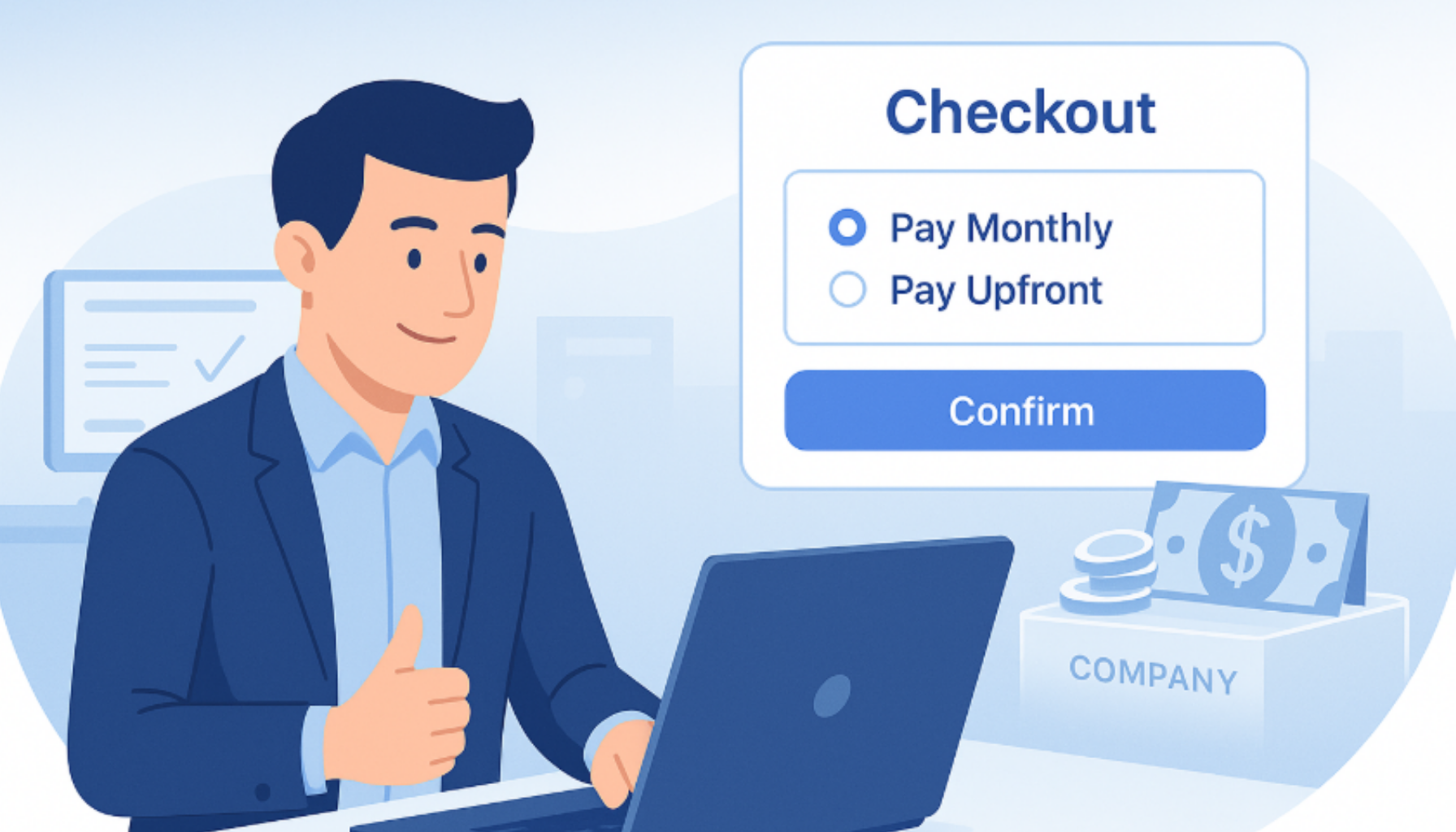| TL;DR - Most SaaS vendors already offer financing to their buyers without realizing it—through Net terms, deferred starts, or monthly payments. While it helps close deals, it ties up cash and leaves you exposed to churn or late payments. This article unpacks the traditional concept of vendor financing through a modern lens: how it’s embedded in SaaS selling today, and how to do it right with smarter tools like Ratio Boost. |
🚨 The Hidden Risk: SaaS sellers are quietly financing their buyers—and it’s draining their growth.
To close deals, teams offer net terms, monthly billing, or deferred starts. Buyers get flexibility. But sellers? They deliver value now and wait —sometimes months—to get paid in full.
It feels like sales enablement, but it’s something else: funding customer affordability out of your own cash flow. Without structure, it erodes margins, slows collections, and increases risk.
- 🕒 CAC payback stretches
- 💸 Discounts pile up
- 📉 Churn, defaults, and forecasting issues grow
📊 A 2025 Kaplan Group survey found that 44.4% of SaaS and tech companies face serious disruption from delayed payments. Another 22.2% lose over 10% of ARR—even when customers are still under contract.
This isn’t just a collections problem or a Go-to-Market (GTM) tradeoff. It’s something else entirely:
A hidden financing model most SaaS sellers are already using—without structure, control, or even realizing it has a name. It’s vendor financing.
Let’s unpack what that practice is, why it’s growing in 2025, and how to turn it into a competitive advantage with smarter tools like Ratio Boost.
🧾What is Vendor Financing?
A legacy concept reshaping SaaS growth in 2025.
Vendor financing has been a staple of B2B trade for decades, especially in industries where big-ticket sales and slow procurement cycles collide. Instead of waiting for bank loans, sellers stepped in and said: “We’ll finance the deal ourselves.”
🫴 In essence: The seller funds the transaction, offering credit or structured payment terms so the buyer can access the product immediately and pay over time—often weeks, months, or even years later.
This payment flexibility typically takes the form of:
- 🧾 Trade credit (Net 30/60/90 terms)
- ⏳ Deferred payments (use now, pay later)
- 📆 Installments (fixed monthly payments)
- 📉 Vendor notes (formal loans, often tied to cash flow or specific assets)
In traditional B2B settings, this kind of financing is structured and priced:
- Sellers evaluate buyer risk
- Charge interest
- Use formal terms to protect cash flow
✅ The goal: Help buyers commit—without third-party financing slowing things down.
If you’re looking for SaaS financing options to fund your growth, check out this blog: [4 SaaS Financing Options to Help Growth-Stage B2B Startups Scale Smarter](https://www.ratiotech.com/blog/saas-financing-options-growth-stage-startups), or dive deeper and compare vendor financing vs. venture debt and revenue financing.
SaaS Is Quietly Doing the Same—But Informally
Now shift to SaaS. The product is delivered digitally. The contracts are subscription-based. But the underlying financial structure? Strikingly similar to traditional vendor financing—and there’s a purpose-built approach in Ratio Boost for SaaS to structure it the right way.
To win deals, SaaS vendors often offer buyers payment flexibility—without calling it financing and without formal infrastructure. The intention is to reduce buyer friction. But in practice, you're quietly financing the deal often without structure or awareness.
You’ve likely seen it:
- Monthly billing instead of annual prepay
- Deferred contract starts
- Net 30/60 payment terms on invoices
- Custom BNPL-style plans for large contracts
- Informal installment agreements with no pricing of risk
These concessions help buyers overcome budget constraints or procurement delays. But they shift the financial burden to the seller.
Here’s how:
- You deliver value now but wait months to get paid
- Your cash is locked in receivables, delaying reinvestment in growth
- You absorb the risk of churn, default, or non-payment
- Your finance team juggles collections, risk, and revenue timing
- And to push the deal through, you often stack discounts on top of it all
All this adds up to one hard truth: SaaS sellers are quietly acting like banks—without the infrastructure, pricing models, or profits that make it worthwhile.
The Model Has Evolved
In the past, vendors who offered payment terms carried the risk themselves—on their own books. But in 2025, vendor financing has evolved.
A new generation of platforms enables what we call embedded, structured vendor financing:
- Embedded: Offered natively within the sales and quoting process
- Structured: Backed by defined terms, schedules, and underwriting
- Risk-offloaded: A third-party financing partner (like Ratio) funds the contract and assumes the repayment risk
Now, instead of waiting to get paid, you collect the full contract value upfront—while your buyer pays over time.
This shift turns vendor financing from a cash flow drag into a growth enabler. It frees your sales team to close faster, your finance team to operate cleaner, and your company to scale without balance-sheet strain.

All of this is only possible with the right vendor financing partner—and Ratio Boost is purpose-built to make it work at scale, giving you an embedded way to offer structured, risk-offloaded terms.
Before we show how Ratio turns vendor financing into a growth strategy, let’s unpack why this model has become essential for SaaS companies in 2025.
Why Vendor Financing Matters for B2B SaaS Companies in 2025
Six-figure SaaS deals are still being signed—but the terms, timelines, and buyer expectations have changed dramatically.
In 2025, SaaS companies are under pressure to move faster, monetize sooner, and sell smarter. And payment flexibility isn’t a “nice to have” anymore, it’s a structural requirement.
To understand why, we’ll unpack the seven forces reshaping how software is bought, sold, and paid for.
Let's start with the first one.
⚙️ Force #1: The Rise of Consumerization in B2B Buying
🔄 What’s Changing
Today’s B2B buyers—especially Millennials and Gen Z—expect software purchases to feel like consumer transactions. Influenced by platforms like Amazon, Klarna, and Stripe, they want:
- Instant quotes and approvals
- Transparent pricing
- Embedded financing options at checkout
- Flexible terms tailored to cash flow
According to Deloitte, over 70% of enterprise buyers now prefer fully digital, self-serve purchasing. and many are willing to spend $50K+ online if flexible payments are built in. For them, financing isn’t an afterthought—it’s part of the buying experience.
Explore how this shift is redefining not just the UX of B2B software—but the mechanics of how it’s financed in our full breakdown of B2B payment consumerization.
⚠️ Why It Creates Pressure
When fast, flexible purchase experiences are expected—but absent—buyers don’t just get frustrated; they pause or walk away.
Sales momentum stalls when reps must:
- Manually generate quotes
- Navigate offline approvals
- Say “no” to flexible payment asks
In a scramble to save the deal, sellers often resort to:
- Ad hoc installment plans
- Discounted annual prepay
- Deferred invoicing
None of these tactics are priced for risk. Most break internal workflows across RevOps, Finance, and Collections. What starts as a UX mismatch turns into a systemic drag—slowing deals, reducing margin, and degrading operational discipline.
⚖️ Force #2: The Collapse of the "Prepay-Only" Sales Model
🔄 What’s changing
Annual prepay was once the gold standard in SaaS—guaranteeing cash upfront, reducing churn risk, and locking in revenue. But in 2025, this model is breaking down.
Buyers, especially in mid-market and enterprise, are resisting large upfront payments. With tighter internal approvals, CFO-led procurement, and shorter budget cycles, even high-intent customers push for pay-over-time models.
Finance teams are no longer approving multi-year contracts without flexibility. Meanwhile, sales teams still face targets built on upfront cash collection.
⚠️ Why It Creates Pressure
This disconnect creates misalignment across the company. Reps are forced to discount heavily or create informal payment schedules to get deals done. But this slows bookings, delays revenue recognition, and clogs Finance with one-off exceptions.
The pressure is operational and strategic:
- Sales cycles stretch
- Forecasting becomes unreliable
- Finance loses control over cash flow timing
- Teams start trading profitability for pipeline velocity
💸 Force #3: Capital is Scarce, Expensive, and Scrutinized
🔄 What’s changing
The free-flowing capital environment that fueled SaaS growth over the past decade is gone. Rising interest rates, cautious VC investors, and a tougher macro outlook have dramatically tightened access to working capital.
For SaaS companies, especially those in mid-market or growth stage, this has meant:
- Fewer equity rounds
- Stricter debt covenants
- Higher cost of capital
- More scrutiny on how every dollar is deployed
Growth is still expected. But now it must be achieved with capital efficiency, not capital availability.
⚠️ Why It Creates Pressure
SaaS businesses are fundamentally front-loaded: you spend upfront to acquire and onboard a customer, but get paid over time. That creates a cash timing gap—even in healthy sales motions.
When access to capital is limited or expensive, this cash lag becomes a blocker. You can’t reinvest in GTM, product, or hiring at the pace needed to hit your targets. Even strong sales performance doesn't convert into usable cash soon enough to support growth.
The result?
- Burn rates rise
- Hiring slows
- Budget reallocation decisions get political
- Founders and CFOs are forced to choose between growth and solvency
🔧 Force #4: Strategic Procurement and CFO Gatekeeping
🔄 What’s changing
In 2025, software buying is no longer controlled by just department heads or budget owners. Strategic procurement, finance controllers, and CFOs have taken a more active role—especially for mid-sized or enterprise contracts.
This shift was accelerated by cost pressures, risk management protocols, and company-wide mandates to eliminate wasteful spend.
As a result:
- Vendor evaluations are more thorough
- Approval workflows are longer
- Scrutiny on payment terms and contract structure is higher
CFOs increasingly look for deferred risk, flexible cash outlay, and commercial terms that align with financial goals—not just user needs.
⚠️ Why It Creates Pressure
Sales teams often secure verbal buy-in from functional leaders—only to get stalled at the procurement gate. Legal, finance, and purchasing teams scrutinize terms like prepay, multi-year lock-ins, or rigid billing structures.
Without commercially adaptive options, deals get delayed, restructured, or dropped.
To unblock them, sellers resort to last-minute concessions: free months, extended trials, or payment delays—all of which hurt margins and make forecasting difficult.
🎯 Force #5: Subscription Fatigue & ROI Pressure
🔄 What’s changing
After a decade of SaaS proliferation, buyers are pushing back. Internal software stacks have ballooned, subscription costs have piled up, and CFOs are under pressure to consolidate vendors and cut recurring spend.
At the same time, economic conditions have made ROI scrutiny more intense. Buyers no longer accept vague promises of future value—they demand measurable impact, faster payback, and lower upfront cost.
This shift is reshaping how purchase decisions are made:
- Fewer vendors get approved
- Payback period is now a gating factor
- Budget holders are skeptical of long-term commitments without near-term value
⚠️ Why It Creates Pressure
This fatigue creates hesitation—especially when SaaS sellers ask for annual prepay, multi-year commitments, or upfront onboarding fees.
Sales teams feel the tension: buyers say they “want it” but stall at budget sign-off. To close the deal, sellers often:
- Discount heavily to shrink payback windows
- Offer free pilots or extended onboarding
- Push out payment start dates to reduce perceived risk
All of these tactics reduce margin, delay cash flow, and complicate revenue operations—turning ROI skepticism into a structural drag on growth.
🧾 Force #6: Competitive Differentiation in GTM
🔄 What’s changing
The SaaS landscape is more crowded than ever. For nearly every category—CRM, marketing automation, data platforms, RevOps—buyers now face 5–10 indistinguishable options. Feature parity is high, switching costs are lower, and buyers have more leverage.
In this environment, go-to-market differentiation can no longer rely on product alone. Buyers compare not just functionality, but:
- Pricing models
- Onboarding speed
- Commercial terms
- Payment flexibility
- Procurement friendliness
Even a 1–2 day delay in quoting, a rigid payment schedule, or a non-negotiable prepay ask can tip the scale toward a competitor.
⚠️ Why It Creates Pressure
When sellers don’t lead with commercial creativity, they’re forced to fall back on discounting. But buyers don’t just want lower cost, they want lower friction.
Sellers who can’t flex on terms lose deals they should win. Those who improvise flexible terms manually create unscalable internal chaos.
The result? You’re either losing to competitors or winning at a margin you can’t afford to sustain.
Now, let’s bring it all together. Each of these forces creates real pressure—but they share a common thread: today’s buyers expect more flexible, manageable ways to pay.
Instead of bending your pricing, processes, or cash flow to accommodate these demands, there’s a smarter path forward. As we outlined earlier, embedded, structured vendor financing—powered by Ratio Boost—lets you meet buyer expectations without compromising your business model.
Here’s how to operationalize it inside your sales motion.
🚀 How Ratio Boost Enables Vendor Financing—Without Changing Your Stack
Most SaaS sellers already act like banks, offering flexible terms, absorbing risk, and waiting to get paid. Ratio Boost changes that by turning every quote into a financed deal, without adding friction or overhauling your sales stack.
Here’s how vendor financing with Ratio Boost works from quote-to-cash:
1️⃣ Embedded in Your CRM
Reps access Ratio Boost directly from Salesforce, HubSpot, or your CPQ. No new logins. No workflow disruption. The financing experience lives inside the quoting flow your team already uses.
2️⃣ Create Offers in Seconds
From the dashboard, reps select or create a buyer, enter contract details, and configure payment terms—monthly, quarterly, milestone-based, or fully custom.
Financing fees can be split, absorbed, or passed to the buyer.

3️⃣ Instant Credit Decisions
Once submitted, Ratio underwrites the deal in real time using the buyer’s EIN and live business data. Most approvals happen in seconds. For larger deals, a lightweight review is triggered—with zero lift from your team.
4️⃣ Buyer Selects a Plan and Signs
Buyers receive a branded, white-labeled offer link with full pricing transparency. They can compare options, select terms, sign electronically, and set up ACH—all in one digital flow.

5️⃣ You Get Paid Upfront
After the buyer signs, Ratio wires the full contract value to your account—typically within 1–3 business days. No collections. No delays. No balance sheet exposure.
Note: Ratio maintains a $411M capital reserve—ready to fund your deals at scale
6️⃣ Ratio Manages Repayment
From there, Ratio handles all invoicing, reminders, collections, and support. Your team stays out of the AR loop—but stays in the loop on deal health and repayment status.
7️⃣ Fast-Track Renewals and Add-ons
All buyer data is saved for future deals. Reps can quote renewals or upsells in seconds—with pre-approved buyers and pre-loaded financing profiles.
In fact, here’s what clients who’ve tried it have to say:
“Ratio is helping us transform the purchasing experience. We see many ways to sell more deals faster—we do it by speeding up the procurement process for our customers. And we collect upfront no matter how the customer pays.”
— David Keane, Founder & CEO @ Bigtincan
Just like David, you can turn procurement friction into conversion velocity—and eliminate upfront payment hurdles without changing your sales motion.
→ → Book a live demo and see how fast, flexible vendor financing can unlock your next wave of growth.
FAQs
1. Does Offering Vendor Financing Make My Company A Lender?
No. With Ratio Boost, your company is not acting as a lender. Ratio handles underwriting, funding, and collections. You simply enable flexible payment options—without regulatory obligations, credit exposure, or balance sheet risk.
2. What Happens If The Buyer Misses Payments Or Defaults?
Ratio fully assumes repayment risk. If the buyer defaults, Ratio manages the collections process independently. Your business keeps the upfront payment, with no clawbacks or AR overhead.
3. Can Vendor Financing Work With Usage-Based Or Custom SaaS Pricing?
Yes. Ratio Boost supports complex deal structures including usage-based billing, milestone-based pricing, and multi-year contracts. It’s purpose-built to match how SaaS companies quote and close—not force standardized terms.
4. How Does Vendor Financing Impact Revenue Recognition Or Accounting?
Vendor financing via Ratio does not alter your revenue recognition policies. Since you receive the full payment upfront, you recognize revenue based on service delivery—not cash collection. This streamlines RevOps and simplifies forecasting. For more details, see the full Ratio Boost FAQs.


.png)







